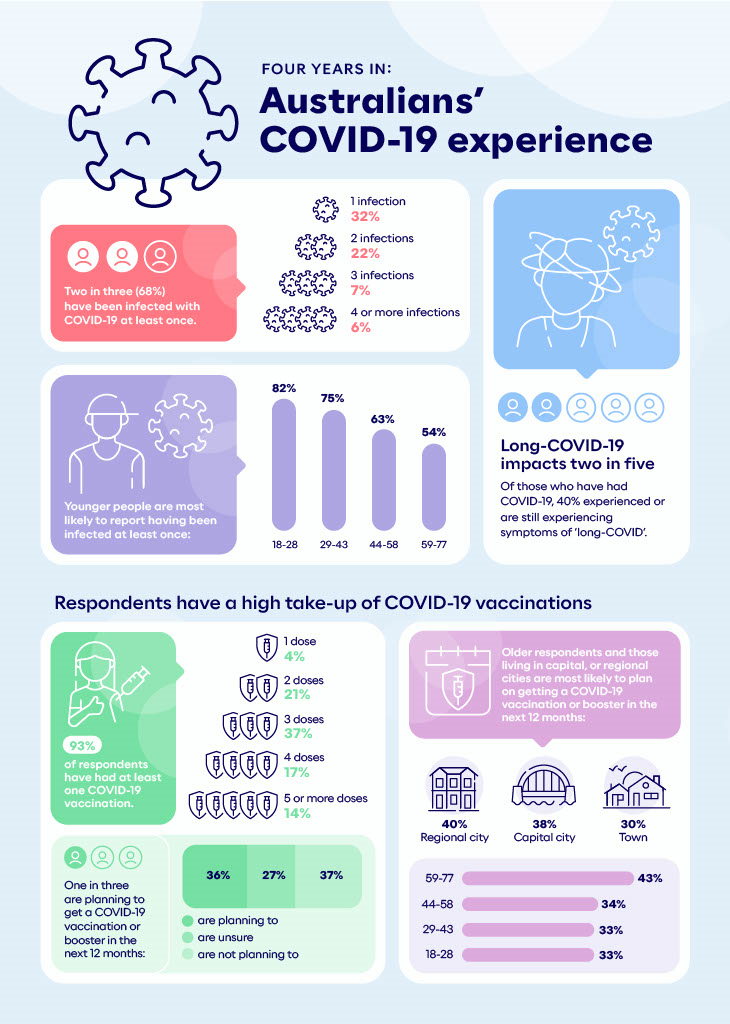

I have just published the findings of Stage 4 of my ‘Australians’ Experiences of COVID-19′ project. The summary and key findings from this survey are provided below. The entire 25-page report is available for download here.
Summary
The national online survey findings reported in this report are from the most recent stage of the ‘Australians’ Experiences of COVID-19’ project. Conducted in mid-September 2023, this representative survey investigates 1,000 Australians’ experiences of COVID-19 and preventive practices such as vaccination and face mask wearing, their perceptions of COVID-19 risk, who they think are the most trusted sources of COVID-19 information and their views on the federal and their state/territory governments’ current management of the pandemic. The survey results show that the pandemic continues to badly affect Australians in terms of accumulated infections and prevalence of long COVID. Yet respondents were equivocal about the extent to which COVID-19 is a continuing risk to Australians. For the most part they were not strongly supportive of continued preventive actions against infection such as face mask wearing and vaccination. They did not hold high trust in any COVID-19 information source, including medical experts and scientists. Respondents were divided about how well their governments were managing the pandemic.
Key findings
- More than two-thirds of respondents (68%) reported having had at least one COVID-19 infection to their knowledge. One third (32%) reported one infection. A further 22% reported two infections, with a total of 13% experiencing three or more. Younger people reported more infections than older people, as did those in the middle household income category.
- Of those who reported COVID-19 infections, 40% had experienced long COVID. More younger people experienced long COVID symptoms, while far fewer people on the lowest household income level reported long COVID.
- The respondents reported a high take-up of the first three COVID-19 vaccines. The vast majority (93%) responded they had been vaccinated, with 21% having had two doses and 36% reporting three doses. However, after three doses, the proportion drops considerably.
- Responses were mixed concerning plans for future COVID-19 vaccination. A total of 36% said they were planning to get another vaccine in 12 months, a similar proportion (37%) said no, and 27% were unsure. Those in the oldest age group were more likely to say that they were planning to get a further COVID-19 vaccination, as were people living in a capital city or regional city.
- Face mask wearing as a personal practice was low. Only 9% of respondents said that they always wore a face mask to protect themselves against COVID-19 when inside public places. A further 26% said that they sometimes used a mask in these settings. This is a combined total of just over one-third of respondents (35%) who were still masking at least sometimes. Younger respondents were more likely to wear face masks than those in the older groups, as were those in the middle income category.
- Support for face mask mandates for healthcare workers while at work was higher, with 58% in at least partial support. Here again, younger people and those in the middle income category were more supportive of mandating face masks for healthcare workers.
- Doctors were considered the most trustworthy sources of COVID-19 information (60%), followed by experts in the field (53%), Australian government health agencies (52%), global health agencies (49%), scientists (45%), community health organisations (35%), Australian government leaders (31%) and other healthcare providers (28%). News reports (17%), friends and family (13%), social media (7%) and religious institutions (3%) were considered the least trustworthy. Older people were more likely to trust doctors and Australian government health agencies. The youngest group was the least trusting of scientists and experts in the field. Those in towns were less trusting of Australian government leaders, global health agencies and experts. Those in the lowest income category trusted news sources more than those in the other categories. A greater percentage of respondents in the two higher income categories said they trusted global health agencies.
- A slight majority (59%) thought that COVID-19 was still posing a risk to Australians: 17% said definitely, while a further 42% saw COVID-19 as somewhat of a risk. This left 28% who did not view COVID-19 as much of a continuing risk, and 13% who thought it not a risk at all. The oldest age group saw COVID-19 as more of a continuing risk to Australians than did the younger groups, as did respondents located in regional cities and towns and those in the middle income category.
- Respondents were mixed in their assessments of how well their federal and state/territory governments were currently managing COVID-19. They were evenly divided between positive assessments (36% for both federal and state/territory governments) and more equivocal assessments: 34% (federal) and 32% (state/territory). The youngest and oldest age groups were least positive about their governments’ management of COVID-19. People in towns were less positive than those in capital cities or regional cities. People with the middle levels of household income were more positive than those in other income categories.